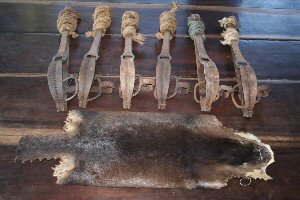Threats facing the Hairy-Nosed Otter
Threats to the Hairy-Nosed Otter (Lutra sumatrana
Taken from Wright et al, 2008, the IOSF and the Furget-Me-Not Campaign website
Fur
 This species, along with all otters in south-east Asia, and many other species,
faces large scale, intensive hunting for the illegal wildlife trade, fuelled
by massive demand from China. In Cambodia, the local fishermen
are hit by depletion of fish in Tonle Sap (due to heavy commercial fishing by
Japanese companies) and are trying to raise their families on about $2 per week,
and a single otter skin can fetch $200 so the temptation is huge. The middlemen
are hard to catch, due to the terrain which makes it very easy to evade the authorities,
and until recently, law enforcement officers were not aware that otters were
endangered as well as tigers, elephants and orang utans. In Vietnam, there was
a huge organised (illegal) campaign during the 1990s to trap otters for the Chinese
trade, with hunters supplied with traps and snares, and with a guaranteed price
- this only stopped when otter numbers fell so low it was no longer economic.
This species, along with all otters in south-east Asia, and many other species,
faces large scale, intensive hunting for the illegal wildlife trade, fuelled
by massive demand from China. In Cambodia, the local fishermen
are hit by depletion of fish in Tonle Sap (due to heavy commercial fishing by
Japanese companies) and are trying to raise their families on about $2 per week,
and a single otter skin can fetch $200 so the temptation is huge. The middlemen
are hard to catch, due to the terrain which makes it very easy to evade the authorities,
and until recently, law enforcement officers were not aware that otters were
endangered as well as tigers, elephants and orang utans. In Vietnam, there was
a huge organised (illegal) campaign during the 1990s to trap otters for the Chinese
trade, with hunters supplied with traps and snares, and with a guaranteed price
- this only stopped when otter numbers fell so low it was no longer economic.
Habitat Destruction
 The
main threat facing otters in Thailand and Sumatra is habitat destruction. On
Sumatra, most of the otter habitat has been destroyed and replaced with oil
palm plantations for biofuel and other uses, but otters seem to still be hanging
on around the swampy fringes of the plantations, though this is only known
from a single roadkill specimen. In Thailand, the peat swamps are being logged
and converted for agricultural use, plus there have been several major fires
that have destroyed habitat; in Vietnam, most of the Mekong delta is converted
to rice fields. Further, in Cambodia, commercial sand mining operations are
destroying river banks and bankside vegetation. The burgeoning population of
south east Asia is also leading to massive conversion of forest land to habitations
and associated farmland.
The
main threat facing otters in Thailand and Sumatra is habitat destruction. On
Sumatra, most of the otter habitat has been destroyed and replaced with oil
palm plantations for biofuel and other uses, but otters seem to still be hanging
on around the swampy fringes of the plantations, though this is only known
from a single roadkill specimen. In Thailand, the peat swamps are being logged
and converted for agricultural use, plus there have been several major fires
that have destroyed habitat; in Vietnam, most of the Mekong delta is converted
to rice fields. Further, in Cambodia, commercial sand mining operations are
destroying river banks and bankside vegetation. The burgeoning population of
south east Asia is also leading to massive conversion of forest land to habitations
and associated farmland.
There is also a problem with invasive foreign waterweeds which are altering
the ecology of the waterways, although whether otters will be net losers or
gainers is not yet clear. Similarly, an invasive south american water
snail, Pomacea
canaliculata, voraciously devours water plants, but again could be a food
source for otters.
Water Pollution
As well as the usual soil and water pollution that comes with increased population (such as sewage), sand mining equipment and ships leak large amounts of oil into the rivers, degrading water condition and reducing prey biomass.
Over fishing
In Cambodia, on Tonle Sap, there has been a massive Japanese commercial fishing industry that has caused the effective collapse of fish stocks. The major prey species now present is water snakes, but there is now a commercial trade in snake skins which is resulting in the removal of tons of snakes from the lake every year. This is having an effect on all piscivorous animals. Otters have become adept at raiding fish traps, which is a cause of conflict with fishermen. There has also been a great deal of overfishing in Vietnam especially in the Mekong delta, with a similar effect. Habitat degradation there has also caused salt and brackish water incursions, which have killed the freshwater crabs which Vietnamese otters used to eat.
Indigenous Use
In Cambodia, otter skin is used in traditional medicine for alleviating problems in childbirth, and also to increase fertility. The meat is also eaten, and the gall bladders and foetuses are also used. In Sumatra (and on Java), people bellieve that otters have a stone in their heads which allow them to swim very fast and hold their breath underwater, and people kill otters to acquire these stones.
| Hairy-Nosed Otter |

